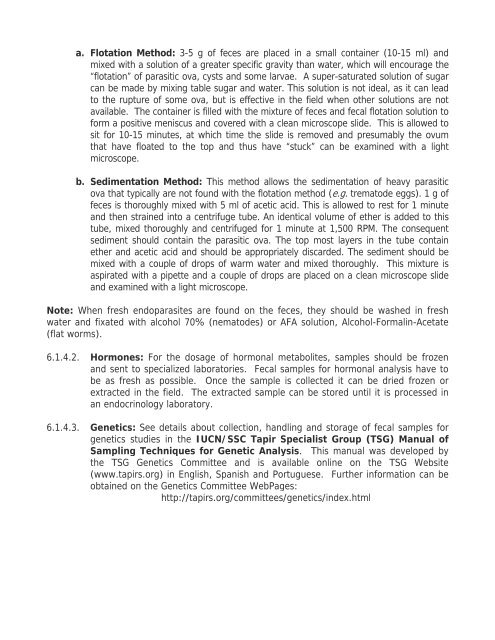TAPIR FIELD VETERINARY MANUAL - Tapir Specialist Group
TAPIR FIELD VETERINARY MANUAL - Tapir Specialist Group
TAPIR FIELD VETERINARY MANUAL - Tapir Specialist Group
Create successful ePaper yourself
Turn your PDF publications into a flip-book with our unique Google optimized e-Paper software.
a. Flotation Method: 3-5 g of feces are placed in a small container (10-15 ml) and<br />
mixed with a solution of a greater specific gravity than water, which will encourage the<br />
“flotation” of parasitic ova, cysts and some larvae. A super-saturated solution of sugar<br />
can be made by mixing table sugar and water. This solution is not ideal, as it can lead<br />
to the rupture of some ova, but is effective in the field when other solutions are not<br />
available. The container is filled with the mixture of feces and fecal flotation solution to<br />
form a positive meniscus and covered with a clean microscope slide. This is allowed to<br />
sit for 10-15 minutes, at which time the slide is removed and presumably the ovum<br />
that have floated to the top and thus have “stuck” can be examined with a light<br />
microscope.<br />
b. Sedimentation Method: This method allows the sedimentation of heavy parasitic<br />
ova that typically are not found with the flotation method (e.g. trematode eggs). 1 g of<br />
feces is thoroughly mixed with 5 ml of acetic acid. This is allowed to rest for 1 minute<br />
and then strained into a centrifuge tube. An identical volume of ether is added to this<br />
tube, mixed thoroughly and centrifuged for 1 minute at 1,500 RPM. The consequent<br />
sediment should contain the parasitic ova. The top most layers in the tube contain<br />
ether and acetic acid and should be appropriately discarded. The sediment should be<br />
mixed with a couple of drops of warm water and mixed thoroughly. This mixture is<br />
aspirated with a pipette and a couple of drops are placed on a clean microscope slide<br />
and examined with a light microscope.<br />
Note: When fresh endoparasites are found on the feces, they should be washed in fresh<br />
water and fixated with alcohol 70% (nematodes) or AFA solution, Alcohol-Formalin-Acetate<br />
(flat worms).<br />
6.1.4.2. Hormones: For the dosage of hormonal metabolites, samples should be frozen<br />
and sent to specialized laboratories. Fecal samples for hormonal analysis have to<br />
be as fresh as possible. Once the sample is collected it can be dried frozen or<br />
extracted in the field. The extracted sample can be stored until it is processed in<br />
an endocrinology laboratory.<br />
6.1.4.3. Genetics: See details about collection, handling and storage of fecal samples for<br />
genetics studies in the IUCN/SSC <strong>Tapir</strong> <strong>Specialist</strong> <strong>Group</strong> (TSG) Manual of<br />
Sampling Techniques for Genetic Analysis. This manual was developed by<br />
the TSG Genetics Committee and is available online on the TSG Website<br />
(www.tapirs.org) in English, Spanish and Portuguese. Further information can be<br />
obtained on the Genetics Committee WebPages:<br />
http://tapirs.org/committees/genetics/index.html










